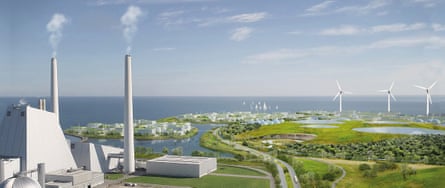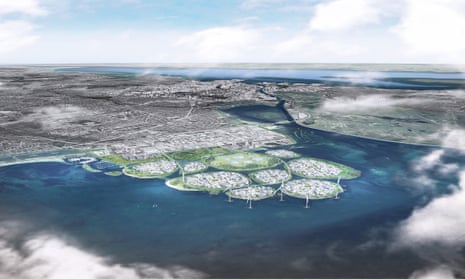In the winter fog and drizzle, it is hard to imagine Køge Bugt beach park packed with families, joggers and swimmers. But in summer this artificial beach is one of Copenhagen’s favourite spots. Backed by scrubby dunes and lagoons teeming with birds, the only thing spoiling the idyll is the power station that looms to the north.
“This view is something that is really part of my childhood,” says Arne Cermak Nielsen.
Nielsen is about to change that view dramatically. A partner at the Copenhagen architecture firm Urban Power, he is leading an audacious scheme to create nine new islands here – the biggest change to the city’s coastline since the 1960s. Together they are intended to form a sustainable leisure and tech hub.
“It’s huge – you can compare it to the centre of Copenhagen,” he says. “The medieval city is 4m sq metres. This is 3m.”
Called the Holmene (Islets), the project was officially launched in January. It will see the municipality of Hvidovre expand by a fifth.
Brian Mikkelsen, head of the Danish chamber of commerce, has boasted that the islands could become “a sort of European Silicon Valley”, luring up to 380 companies in the biotech, pharmaceutical and life sciences sectors and creating as many as 12,000 new jobs. Less complimentary comparisons have also been made to another artificial archipelago – Dubai’s The World, which was completed on the eve of the financial crash only to spend a decade empty and abandoned.
When Avedøre, the industrial area, was itself reclaimed in the 1970s, the engineers simply let its asphalt edge drop directly into the sea. It is a sign of how times have changed that the new islands will be ringed by 70 hectares of parkland. Urban Power envisages cyclists and kayakers on their fringes, wooden towers for birdwatchers, and spearfishers hunting on new artificial reefs.
“You can construct the islands to make different conditions,” Nielsen says, pointing at the different islets on his screen. “So here you can create a shore which gets partly flooded, a salty wetland structure. Some of it has reefs, some of it has a beach structure. You can create different kinds of biotopes.”
The hope is that all this greenery will act as a buffer between Køge Bugt beach park and Kalvebod Fælled, the wetlands across the water.
But not all locals are convinced.

“I don’t like it,” says Birgitte Meier, who has biked from Brøndby Strand, a nearby beachside district, for her daily swim despite the freezing February rain. “You can have the factories in other places in Denmark.”
“They tell us we can have both, nature and industry,” adds her friend Bente Barting. “But I don’t know how it’s going to be in the future.”
As of yet, the only business to have signed up for one of the islands is the city’s municipal sewage company Biofos, which plans to build northern Europe’s largest wastewater treatment plant on the biggest, Green Tech Island. The aim is for the plant to generate enough power for 140,000 people, about a quarter of the city’s population, and cut the city’s CO2 emissions by 74,000 tonnes a year.
On the bus back to central Copenhagen, I meet Mary Petersen, an Englishwoman who moved to Brøndby Strand with her Danish husband in the 1960s. She is worried about traffic congestion, an issue also raised by the mayors of Brøndby and next-door Ishøj.
“The traffic that comes in from the southern suburbs in the morning is absolutely horrific,” she says.
Hvidovre says it will start lobbying for a bus rapid transit link from the city centre, with its own dedicated lanes. There are also hopes the planned light rail line across the city can be extended. But nothing has yet been decided.
Neighbouring mayors have questioned how the islands will affect the currents along their respective stretches of Køge Bugt beach. The Danish water consultancy DHI studied the early designs and modelled the currents, leading Urban Power to reshape several of the islands and increase the width of the channels between them to a minimum of 40 metres.
There has also been criticism from a group of retired urban planners who published a joint article arguing the city should place new industrial clusters further out, as part of a radical reform to the city’s 70-year-old “Finger Plan” urban development strategy.
“It’s crazy,” says Niels Boje Groth, senior researcher emeritus at the University of Copenhagen, who wrote the letter. “There is a problem with concentrating [development] in the centre. It means that property values increase, and you need to facilitate the much greater amount of traffic that is generated.”
Steffen Damsgaard, chair of the Danish Council of Rural Districts, says the government should instead be spending money boosting the economies of depressed rural areas.
“Urbanisation in Denmark so far has seen people of the same social class moving together into some areas, and foreigners into other areas,” he says. “It has not created a vibrant, good society, but has created some issues.”
Nielsen argues Damsgaard’s criticism comes from a misconception that the project is publicly funded, when it is in fact self-funding. The islands are a distraction from the project’s more mundane underlying purpose: to find a place to dump close to 30m tonnes of soil from Copenhagen’s metro expansion and other projects.
The payments Hvidovre municipality receives for taking the soil will cover the cost of creating the islands, while selling the plots will more than cover the cost of power, roads and other infrastructure. Or at least that’s the idea.

The islands are also intended to help protect Copenhagen’s southern coastline against rising sea levels. Some of the earth will be used to build a dyke around Avedøre, the city’s lowest-lying area, increasing the coastal height at the edge from 3 metres to 5.5 metres.
Initial proposals from architecture firms made these utilitarian functions much more obvious. The idea of building nine islands rather than a perviously proposed rectangular block came from Nielsen’s partner in Urban Power, Sara Buhl Bjelke. Before the industrial area was reclaimed in the 1970s, there had been seven large islands and several smaller ones off this coast.
“During one afternoon meeting, she just looked up and said, ‘Well, that’s of course what we should do,’” Nielsen says. “It’s the storytelling: ‘The islands that were lost.’”
Gert Nelth, the director of Hvidovre’s central administration, was enthusiastic.
“It will be beautiful, will function in the right way, and was in all senses the right angle for the project,” Nelth says. “We were incredibly excited about it.”
The islands will be more expensive than the block would have been, but will allow the municipality to develop the project in steps from 2022 onwards as the earth arrives, giving it the option of slowing the project down or even halting it. Equally, more islands could be added. The project will now have to undergo an environmental impact assessment and further public consultation before work starts.
It is easy to forget that Brøndby Strand, with its thick beachgrass covering its dunes and the trees behind it, did not exist before 1980. Kalvebod Fælled and the popular Amager beach park were also created rather than occurring naturally.
Before I leave, Nielsen shows me a slideshow of Copenhagen’s development, showing how the entire historic district of Christianshavn was built on artificial islands back in the 17th century.
The inspiration for Urban Power’s bold idea, he says, comes not from Dubai’s attention-seeking archipelago, but from Copenhagen’s own history.
“A lot of the streets here are called ‘holmen’, which means they were muddy islets originally,” he says, pointing at the city’s medieval centre. “So all of this is artificial. It’s kind of a tradition, you could say.”
Follow Guardian Cities on Twitter, Facebook and Instagram to join the discussion, catch up on our best stories or sign up for our weekly newsletter
